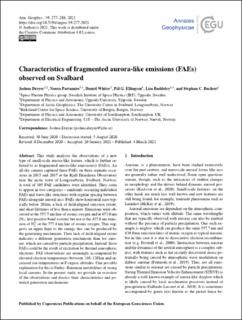| dc.contributor.author | Dreyer, Joshua | |
| dc.contributor.author | Partamies, Noora | |
| dc.contributor.author | Whiter, Daniel | |
| dc.contributor.author | Ellingsen, Pål Gunnar | |
| dc.contributor.author | Baddeley, Lisa | |
| dc.contributor.author | Buchert, Stephan C. | |
| dc.date.accessioned | 2021-08-13T07:40:53Z | |
| dc.date.available | 2021-08-13T07:40:53Z | |
| dc.date.created | 2021-06-22T12:36:55Z | |
| dc.date.issued | 2021 | |
| dc.identifier.issn | 0992-7689 | |
| dc.identifier.uri | https://hdl.handle.net/11250/2767703 | |
| dc.description.abstract | This study analyses the observations of a new type of small-scale aurora-like feature, which is further referred to as fragmented aurora-like emission(s) (FAEs). An all-sky camera captured these FAEs on three separate occasions in 2015 and 2017 at the Kjell Henriksen Observatory near the arctic town of Longyearbyen, Svalbard, Norway. A total of 305 FAE candidates were identified. They seem to appear in two categories – randomly occurring individual FAEs and wave-like structures with regular spacing between FAEs alongside auroral arcs. FAEs show horizontal sizes typically below 20 km, a lack of field-aligned emission extent, and short lifetimes of less than a minute. Emissions were observed at the 557.7 nm line of atomic oxygen and at 673.0 nm (N2; first positive band system) but not at the 427.8 nm emission of N+2 or the 777.4 nm line of atomic oxygen. This suggests an upper limit to the energy that can be produced by the generating mechanism. Their lack of field-aligned extent indicates a different generation mechanism than for aurorae, which are caused by particle precipitation. Instead, these FAEs could be the result of excitation by thermal ionospheric electrons. FAE observations are seemingly accompanied by elevated electron temperatures between 110–120 km and increased ion temperatures at F-region altitudes. One possible explanation for this is Farley–Buneman instabilities of strong local currents. In the present study, we provide an overview of the observations and discuss their characteristics and potential generation mechanisms. | en_US |
| dc.language.iso | eng | en_US |
| dc.publisher | Copernicus Publications | en_US |
| dc.rights | Navngivelse 4.0 Internasjonal | * |
| dc.rights.uri | http://creativecommons.org/licenses/by/4.0/deed.no | * |
| dc.title | Characteristics of fragmented aurora-like emissions (FAEs) observed on Svalbard | en_US |
| dc.type | Journal article | en_US |
| dc.type | Peer reviewed | en_US |
| dc.description.version | publishedVersion | en_US |
| dc.rights.holder | Copyright Author(s) 2021 | en_US |
| cristin.ispublished | true | |
| cristin.fulltext | original | |
| cristin.qualitycode | 1 | |
| dc.identifier.doi | 10.5194/angeo-39-277-2021 | |
| dc.identifier.cristin | 1917672 | |
| dc.source.journal | Annales Geophysicae | en_US |
| dc.source.pagenumber | 277-288 | en_US |
| dc.identifier.citation | Annales Geophysicae. 2021, 39 (2), 277-288. | en_US |
| dc.source.volume | 39 | en_US |
| dc.source.issue | 2 | en_US |

